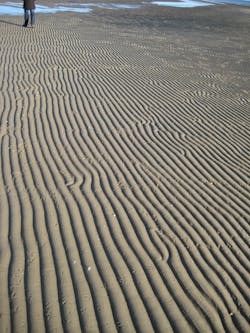
Researchers at the University of California–Los Angeles (UCLA) and the University of Göttingen (Göttingen, Germany) have used a unique high-speed measurement technique to demonstrate that patterns that develop in ultrafast laser pulses mimic wave patterns found in nature. Not otherwise discernible with conventional ensemble measurement methods, the patterns were seen by analyzing single-shot spectra of “modulation instability”—a nonlinear interaction that leads to pattern formations in nature such as sand ripples, water waves, and heart rhythms—produced by ultrashort laser pulses in optical fibers.
In the experiment, 1550 nm, 25 MHz repetition-rate, 3 ps pulse-duration laser pulses are injected into a nonlinear optical fiber to create spontaneously growing oscillations (frequency modes) that are then captured by stretching the output in a spool of dispersive fiber to record the subnanometer optical spectrum of each pulse. Statistical analysis of the thousands of individual pulses allows the researchers to identify an interactive effect between the frequency modes: within a pulse, overlapping modes at similar frequencies either unite or suppress each other, leaving only one to dominate in the end. Conventional time-averaged measurement records spectrally broad modulation-instability sidebands (well-known in nonlinear optics), hiding the interactive effect between the underlying discrete modes. Their observations suggest that similar interactions may be at work in other physical contexts (for example, sand undulations) in which single temporal or spatial patterns become dominant. Contact Daniel Solli at [email protected].

Gail Overton | Senior Editor (2004-2020)
Gail has more than 30 years of engineering, marketing, product management, and editorial experience in the photonics and optical communications industry. Before joining the staff at Laser Focus World in 2004, she held many product management and product marketing roles in the fiber-optics industry, most notably at Hughes (El Segundo, CA), GTE Labs (Waltham, MA), Corning (Corning, NY), Photon Kinetics (Beaverton, OR), and Newport Corporation (Irvine, CA). During her marketing career, Gail published articles in WDM Solutions and Sensors magazine and traveled internationally to conduct product and sales training. Gail received her BS degree in physics, with an emphasis in optics, from San Diego State University in San Diego, CA in May 1986.